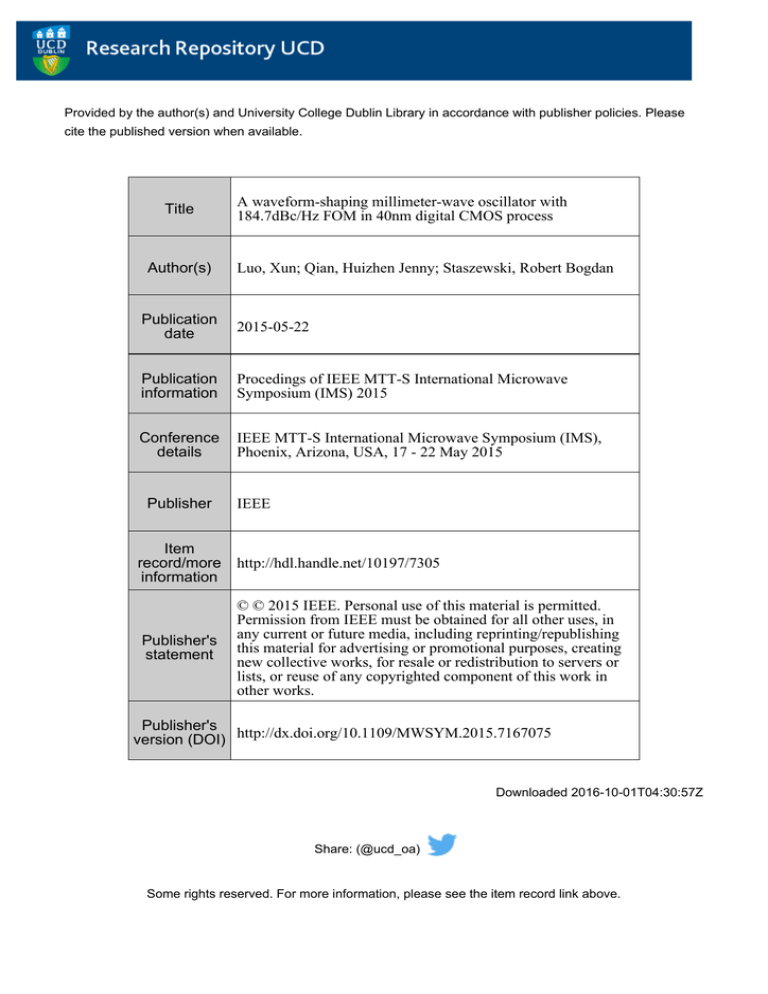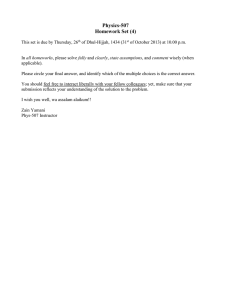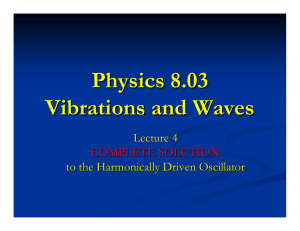
Provided by the author(s) and University College Dublin Library in accordance with publisher policies. Please
cite the published version when available.
Title
Author(s)
A waveform-shaping millimeter-wave oscillator with
184.7dBc/Hz FOM in 40nm digital CMOS process
Luo, Xun; Qian, Huizhen Jenny; Staszewski, Robert Bogdan
Publication
date
2015-05-22
Publication
information
Procedings of IEEE MTT-S International Microwave
Symposium (IMS) 2015
Conference
details
IEEE MTT-S International Microwave Symposium (IMS),
Phoenix, Arizona, USA, 17 - 22 May 2015
Publisher
IEEE
Item
record/more
information
http://hdl.handle.net/10197/7305
Publisher's
statement
© © 2015 IEEE. Personal use of this material is permitted.
Permission from IEEE must be obtained for all other uses, in
any current or future media, including reprinting/republishing
this material for advertising or promotional purposes, creating
new collective works, for resale or redistribution to servers or
lists, or reuse of any copyrighted component of this work in
other works.
Publisher's
version (DOI) http://dx.doi.org/10.1109/MWSYM.2015.7167075
Downloaded 2016-10-01T04:30:57Z
Share: (@ucd_oa)
Some rights reserved. For more information, please see the item record link above.
A Waveform-Shaping Millimeter-Wave Oscillator with 184.7dBc/Hz
FOM in 40nm Digital CMOS Process
Xun Luo1,2 , Huizhen Jenny Qian1 , and R. Bogdan Staszewski1
1 Delft University of Technology, 2628CD Delft, The Netherlands
2 Huawei Technologies Co., Ltd., 518129 Shenzhen, China
Resonator 3
Abstract—In this paper, a topology for millimeter-wave (mmwave) oscillator with a waveform-shaping operation is proposed
with improved phase-noise. The 3rd Harmonic enhancement
for enforcing a pseudo-square voltage waveform and adjustable
tuning-banks for wide tuning range are simultaneously achieved,
based on a multi-stage broadside-coupled transformer (MSBCT)
with reconfigurable coupling factors at mm-wave. Meanwhile,
to meet the high-Q, high-resolution, and metal density limits, a
novel 3D self-shielded capacitor is developed for implementation
of tuning-banks operating at mm-wave. To verify the mechanism
and structures above, a waveform-shaping mm-wave digitallycontrolled oscillator (DCO) is fabricated. The proposed oscillator
has a state-of-the-art figure-of-merit (FoM) of 184.7dBc/Hz at
58.1 GHz under 110◦ C, despite being realized in a digital CMOS
40nm process without customary ultra-thick metal option. The
resolution for this DCO is about 2.5MHz within the whole tuning
range. The chip micrograph with core size of 315um by 110um.
Index Terms—3D self-shielded capacitor, digitally-controlled
oscillator (DCO), multi-stage broadside-coupled transformer
(MSBCT), waveform-shaping, millimeter-wave (mm-wave).
Fig. 1. Concept and topology of the tri-coupled resonator using multi-stage
transformer.
I. I NTRODUCTION
II. O SCILLATOR T OPOLOGY AND O PERATION
Millimeter-wave (mm-wave) oscillators for high-data-rate
wireless communications in 60GHz and E-band require very
low phase noise at preferably low power consumption [1], thus
historically favoring SiGe technology. Recently, waveformshaping has been explored at single-GHz frequencies in
CMOS technology to create a square-like waveform (through
clipping or harmonic shaping [2]) of the oscillation voltage
across the tank, which results in a lower rms value of the
impulse sensitivity function (ISF) and thus less circuit noise
contribution to phase noise. At the mm-wave, however, an
attempt at controlling odd harmonics of the square-like signal
(see equation in Fig. 1) is utmost challenging due to parasitics.
Furthermore, to overcome severe degradation of varactorQ at mm-wave, digitally controlled oscillators (DCOs) with
digitally controlled artificial dielectric (DiCAD) were developed [3]. Nevertheless, the coupling among adjacent units of
DiCAD degrades linearity of the tuning banks [4].
In this work, the phase noise and figure-of-merit (FoM)
of a mm-wave oscillator are significantly improved in digital
CMOS technology in order to make it competitive compared
to SiGe. Two techniques are introduced: (1) tank of tri-coupled
resonators for waveform-shaping through harmonic tuning to
achieve low phase noise; and (2) high-Q 3D self-shielded
capacitors for highly linear frequency tuning without the tanks
Q-factor degradation.
The first proposed technique creates harmonics in the mmwave oscillator tank, which uses the tri-coupled resonators
consisting of primary, secondary, auxiliary windings and tuning capacitors. The multi-stage transformer (i.e., TP1, TP2,
and TP3) as shown in Fig. 1 is introduced to realize windings
in the resonator. Two main resonances (i.e., fosc1 and fosc2 )
can arise and be adjusted to fosc2 = 3fosc1 with magnetic
coupling around km1 of 0.73, while km1 is with a function of
L2 /L1 , L2 /L3 , C2 /C1 , and C2 /C3 . The coupling factors km2
and km3 of TP2 and TP3 can affect the tuning step size, only
with slight shift of fosc2 (i.e., fosc2 ≈ 3fosc1 ). Note that, the
1-dB bandwidth of mag(fosc2 ) in the transfer function from
passive tank is about 15%, which affords a wideband tolerance
of frequency shifting to meet the fosc2 magnitude limits of
equation in Fig. 1 with proper loop gain. Therefore, the
fundamental frequency and third-order harmonic can coexist in
the tank, thus meeting the requirements to implement a squarelike waveform. Considering that the coupling factors are the
key issue to control the resonances for waveform-shaping,
the multi-stage broadside-coupled transformer (MSBCT) is
introduced as depicted in Fig. 2. The primary, secondary, and
third windings of the MSBCT are implemented on different
metal layers (M7, M8, and AP). The primary and secondary
windings are broadside-coupled with an overlap of d, which
can enhance the magnetic coupling for improved coupling
Vin
1 : n2
TP3
km3
Resonator1
L3
km2 TP2
n2 : n1
km1
1 : n1
TP1 L2
C2
C1
C3
C3
Vin
L1
Vout
Rosc1
2Rosc2
L1 M12
L2/L1 = 3, L2/L3 = 4
C2/C1 = 1, C2/C3 = 25
km2 = 0.2, km3 = 0.1
km1 = 0.73
km1 = 0.665
km1 = 0.6
Rosc2
|Zin(jω)|
Rosc1
Rosc1
2Rosc2
Rosc2
12.5 dB
0
fosc1
fosc2
3fosc1
fosc2
Frequency
Vout/Vin (dB)
fosc1
Gain (dB)
Vout
M32
C2
M12
L2 M12
Fourier series of
square-wave signal
Resonator 2
|Zin(jω)|
Rosc1
M13
C1
L2/L1 = 3
L2/L3 = 4
C2/C1 = 1
C2/C3 = 25
km1 = 0.73
fosc2 3fosc1
km2 = 0.1, km3 = 0.1
km2 = 0.1, km3 = 0.35
km2 = 0.35, km3 = 0.1
km2 = 0.35, km3 = 0.35
fosc2
km2 = 0.1, km3 = 0.1
km2 = 0.1, km3 = 0.35
km2 = 0.35, km3 = 0.1
km2 = 0.35, km3 = 0.35
Frequency
Frequency
5 MHz/fF
3.5 MHz/fF
2 MHz/fF
1 MHz/fF
C3
w2/w1 = 2
w2/w1 = 1
w2/w1 = 0.5
Vias
km1
MSBCT
VDD
w1
g1
km2
w2
km2
Drain A
T1
dc
dc
Self-Shielded
1 Cell
2 Cell
Middle
Cell
M1−M2
M1−M4
M1−M6
M1−M3
M1−M5
3 Cell
M1−M2
gc : wc : dc = 1 : 1 : 2
gc : wc : dc = 1 : 2 : 4
M1−M3
M1−M4
M1−M5
M1−M6
Big Cell
Coarse Tune
Mid-coarse Tune
Fine Tune
Drain B
Drain A
Drain B
To Tank
ISF
Voltage (V)
Mid-coarse Tune
M1
gc : wc : dc = 1 : 1 : 1
gc : wc : dc = 1 : 2 : 1
M1
Gate B
M1−M2
M1−M4
M1−M6
M1−M3
M1−M5
60 GHz
g2/w3
Gate A
EN
wc
k
km3
w3/w1 = 2
w3/w1 = 1
w3/w1 = 0.5
T2
Resistor-Loaded
Current Source
2 unit cells
1 unit cell
1 unit cell
km3
Gate B
Coarse Tune
60 GHz
2 unit cells
M1
w1
Drain B
Gate A
60 GHz
Vias
gc
g1/w3
g2
C
M1~M6
Ctot = Cv + Ch
w3/w2 = 2
w3/w2 = 1
w3/w2 = 0.5
w3
Vgate
C
Surround-horizontal
capacitor, Ch
d/w2
w3
3 unit cells
3 unit cells
M7
Vertical capacitor, Cv
Q
d
Capacitance (fF)
w2
km1
AP
M8
M7
Fine Tune
To Switch-Array
T3
Time (ns)
Time (ns)
Fig. 3. Characteristics, layout, and implementation of the proposed 3D selfshielded capacitor.
Fig. 2. Schematic and transformer layout of the mm-wave waveform-shaping
oscillator.
factor km1 . Considering the substrate height among the metal
layers, the third winding is located on the AP layer with
relative large gaps (g1 and g2 ) to the former two windings
for decreasing the coupling. Therefore, to properly adjust the
ratios of width (w2 /w1 , w3 /w2 , and w3 /w1 ) under various
cases of overlap/gap to width ratios (d/w2 , g1 /w3 , and g2 /w3 ),
respectively, the coupling factors of km1 , km2 , and km3 can
be precisely controlled. To introduce enough loop gain of the
tank, transistors T1,2 operate in the triode-region. The resistorloaded tail is used to fix the oscillator current. Once powered
up, the oscillator starts fluctuating at fundamental frequency
since it needs lower loop gain. Then, as the oscillation amplitude grows, the current and loop gain increase. Therefore,
the second resonance is excited. With a limited current from
the source tail, the magnitude of the dual resonances go
to a steady state of mag(fosc1 ) ≈ 3mag(fosc2 ). Thus, the
waveform-shaping of the oscillator at mm-wave is achieved
with ISF of lower rms (enhanced flatness in the oscillator
period), which further improves the phase noise and power
efficiency compared to the conventional mm-wave oscillators.
The capacitor design in the resonant-tank is also the key
issue affecting the final oscillator performance (i.e., phase
noise and tuning step with good linearity). In order to further
reduce the losses and improve the Q-factor, a 3D self-shielded
capacitor is proposed, as shown in Fig. 3. There are two
main contributions to the capacitance. The first part is due to
the horizontal surrounding coupling, which is denoted by Ch
(red); the second part is the vertical surface-to-surface coupling
through the substrate, which is denoted by Cv (blue). The goal
is to maximize Ch , while minimizing Cv , in order to avoid the
capacitive coupling through the substrate with lossy dielectric.
Especially in mm-wave operation, this implementation (i.e.,
Ch > Cv ) effectively reduces the substrate loss and greatly
improves the Q-factor. Under limits of the 40nm CMOS DRC
rules, the smallest unit cell operating at 60 GHz can introduce
a capacitance around 2fF and Q > 40. Note that, the value
of the horizontal capacitors Ch can be properly adjusted by
the stacked metal layers (i.e., M1−M6), which make a good
enough flexibility to achieve specific design requirements.
Considering the stacked structure of the capacitor, it is easy
to meet the limits of metal-density in the nanoscale CMOS
technology. Meanwhile, the self-shielding of the proposed
capacitor can decrease the coupling effect to the adjacent
cells under a proper ratio of dimensions (i.e., gc : wc :
dc ), which can further improve the linearity of switchedcapacitor array. In addition, the proposed capacitor is flexible
to achieve different capacitance (i.e., large, middle, and small)
with various composition of unit cells, as shown in Fig. 3.
Based on the proposed 3D self-shielded capacitor, the switchcap arrays (coarse-, middle-, and fine-bank) in the tank with
high linearity and high-Q are achieved, simultaneously.
III. I MPLEMENTATION AND E XPERIMENTAL R ESULTS
The prototype oscillator is fabricated in 40nm 1P8M digital
CMOS without ultra-thick-metal. The core transistors T1,2
are 22.5um/40nm. The positive feedback is realized by a 1:2
step-up broadside-coupled transformer (TP1) with primary and
secondary Q factors of 10 and 16, respectively. The Q of
the third winding in the additional transformer is about 18.
34 switched loaded self-shield capacitors (C0-C17 and M0M15) across secondary winding form the coarse tune and
mid-coarse tune banks. Meanwhile, a pair of fixed capacitors
adjust the fosc2 near 3fosc1 for specific frequency tuning range
(about 15%) with the improved phase noise. Besides, 25 and
7 switched loaded self-shield capacitors (F0-F24 and P0-P6)
located on the third winding are used to achieve fine-tune
banks with PVT tolerance.
Measured characteristics of the proposed waveform-shaping
mm-wave oscillator are obtained by a test setup, as shown in
Fig. 4. The phase noise is tested using the external fundamental down-converter and R&S signal source analyzer with
a PLL-mode. The oscillator spectrum is directly measured
using the R&S spectrum analyzer. The results in Fig. 4 are
tested in a temperature chamber at 110◦ C. The phase noise
of -99.5dBc/Hz at 1MHz offset with a 58.1 GHz carrier is
achieved with an output power of -5.41 dBm. Figure 5 shows
-30 dB/dec
Signal
Generator
Driver
DC
SPI
DUT
Signal
Source
Analyzer
Spectrum
Analyzer
X3
Mixer
Bias-T
Temp. Champer
-20 dB/dec
Test Setting
Fig. 4. Measured phase noise and spectrum with a 58.1 GHz carrier at 110◦ C
temperature.
Fig. 6. Performance summary and comparison with state-of-the-art mm-wave
oscillators.
Coarse tune thermometer code index
18
17
16
15
14
13
12
11
10
9
8
7
6
5
4
3
2
1
0
Decoder
315 um
PVT FT
Mid-coarse tune thermometer code index
MSBCT
CT MT
。
。
。
。
。
。
。
。
Fig. 5. Measured results of the frequency range and step sizes for coarse,
mid-coarse, and fine tuning banks; phase noise at 1MHz offset at different
carriers; FOM and FOMT at different coarse-band settings.
the tuning-bank characteristics of the oscillator with good
linearity. The fine-tuning steps of 2.1, 2.4, and 3.2 MHz are
achieved at lower, middle, and high operating frequencies,
respectively. The phase noise, FOM, and FOMT under different temperature conditions demonstrate that the proposed
waveform-shaping mm-wave oscillator has a competitive performance, covering the whole operation frequency bands with
tuning ranges around 14.8%.
Experimental results are summarized and compared to recently reported mm-wave oscillators (i.e., VCOs and DCOs in
various CMOS and SiGe processes) in Fig. 6. The proposed
waveform-shaping oscillator has a state-of-the-art FOM of
184.7dBc/Hz at 58.1 GHz under 110◦ C, despite being realized
in a digital CMOS 40nm process without the customary ultrathick metal option. The chip micrograph with core size of
315um by 110um is shown in Fig. 7.
110 um
Fig. 7. Chip microphotograph of the poprosed mm-wave waveform-shaping
oscillator.
IV. C ONCLUSION
In this paper, the novel MSBCT and 3D self-shielded capacitor are utilized to design mm-wave DCO, which can achieve
waveform-shaping and high-resolution tuning, simultaneously.
Phase noises in the whole tuning-band is specifically optimized
for improved performance. The state-of-the-art measured results of the mm-wave DCO around 60GHz is first achieved.
R EFERENCES
[1] T. Nakamura, et al., “A 59GHz push-push VCO with 13.9GHz tuning range using loop-ground transmission line for a full-band 60GHz
transceiver,” ISSCC Dig. Tech. Papers, pp. 495–496, Feb. 2009.
[2] M. Babaie, et al., “A class-F CMOS oscillator,” IEEE J. Solid State
Circuits, vol. 48, no. 12, pp. 3120–3133, Dec. 2013.
[3] T. LaRocca, et al., “CMOS digital controlled oscillator with embedded
DiCAD resonator for 5864 GHz linear frequency tuning and low phase
noise,” International Microwave Symposium, pp. 685–688, Jun. 2009.
[4] W. Wu, et al., “High-resolution millimeter-wave digitally controlled
oscillators with reconfigurable passive resonators,” IEEE J. Solid State
Circuits, vol. 48, no. 11, pp. 2785–2794, Nov. 2013.
[5] U. Decanis, et al., “A mm-wave quadrature VCO based on magnetically
coupled resonators,” ISSCC Dig. Tech. Papers, pp. 280–281, Feb. 2011.
[6] Q. Wu, et al., “A 10mW 37.8GHz current-redistribution BiCMOS VCO
with an average FOMT of -193.5 dBc/Hz,” ISSCC Dig. Tech. Papers, pp.
150–151, Feb. 2013.





